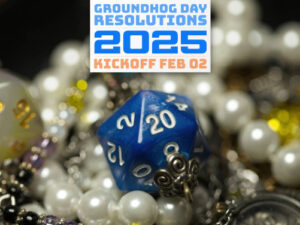(last edited on February 15, 2023 at 12:26 pm)
 Woohoo, I finally woke up before 7AM to get an early start on Day 4 of my 2016 Groundhog Day Resolution Challenge! Today I’m building on the work from yesterday’s point value list, which identified “tasks that contribute to my goals”, for the design of a Groundhog Day Resolutions Tracker based on my old concrete goals tracker form. While I am getting a little antsy about not having it done yet for actual goals, I think the progress I made today is still pretty cool. Read onward for some more about how the tool might work; keep in mind this is a work in progress!
Woohoo, I finally woke up before 7AM to get an early start on Day 4 of my 2016 Groundhog Day Resolution Challenge! Today I’m building on the work from yesterday’s point value list, which identified “tasks that contribute to my goals”, for the design of a Groundhog Day Resolutions Tracker based on my old concrete goals tracker form. While I am getting a little antsy about not having it done yet for actual goals, I think the progress I made today is still pretty cool. Read onward for some more about how the tool might work; keep in mind this is a work in progress!
The Challenge of Logging Points
So, the idea of a tracker is to serve as a coach (which is what yesterday’s work was about) and also to provide useful feedback (which is today’s work). The requirements for this tracker is a little more complicated than the original Concrete Goals Tracker, which tracked only a single goal at a time like Do stuff that will make you a successful freelancer. This GHDR tracker, by comparison, has to track 9 different goals and somehow provide focus and feedback! The second challenge is to create a data entry method that is simple and generates a useful report on-the-fly.
Regarding the former challenge, I was able to find the commonality across all nine goals by focusing on SUPPORTS leading up to RESULTS for all of them. If you’re learning to be more creative, the way to do that is to be creative in the sense that you are actually making things, and this is why the Concrete Goals Tracker is an excellent base to start from as it emphasizes so-called “concrete goals”; that is, goals that can be seen and therefore measured. But the second challenge of handling the data entry was a little less certain, because having nine different goals means potentially tracking nine different categories of result, adding a second dimension.
So I just started making the tracker, trying to line-up the points list with the tracker as I went. After a bit of massaging the look, I realized that I could create a left-to-right workflow that made some sense.
It seemed to me that the purpose of this tracker not comprehensive capture, but focus. The focus I am designing for is “producing tangible results that actually advance one toward one of nine goals”, and therefore the elements in the form should suggest the process that makes this happen. Let’s diagram this from left-to-right:
Remember what the goals are, and what matters – Rather than leave it to the vagaries of memory, I list all the goals AND what I consider a “tangible result”. The language is generic enough to apply to a broad variety of tasks for each goal, and also specific in providing a result test; if I can’t say, “yes I made a code commit to my Github repo for the project”, I can’t claim to have delivered a 10-point result. That’s the rule, no arguments allowed.
Choose something to do – After perusing the goal menu, it’s up to me to come up with something to do. I figure here I would write one things to try at a time when I am selecting the day’s GOAL PUSH. I just want something to remind me what my topical task focus is; it could be something like, “draw a doodle of a spaceship” or “add bullets to my space game”. It’s likely to be something that can’t be done easily in one sitting, but that’s where the next column comes into play.
Hammer away at the task, and award points for supporting work – The point assignment section rewards actions that are part of the hard work of delivering a result. This includes “soft” actions like social interaction (good for maintaining energy and random insights) as well as research and planning. There are even rewards for approaches that will get you unstuck, like “trying something you don’t think will work” and “reducing the scope” just to get something to happen. For someone who is grubbing for as many points as possible by stretching these definitions as far as they will go (which I highly encourage as this is mindfulness in action).
Achievement Grid – This form is providing space for a week’s worth of goal pushing. You fill-in a bubble every time you earn some points during the day, and I think one would be able to roughly remember them by consulting the second column; if more detail is needed, using a concrete goal-supporting version of the ETT and ETP would probably be ideal for that, as these have the space. Over the course of the week, the bubbles will fill up and show the pattern of your work. For example, if you’re seeing mostly a lot of 1-2 point activity, you might be ramping up OR maybe you’re not pushing yourself hard enough (basically you are just talking to people and reading articles). If you see more 2-3 point activities, you’re at least trying some new processes and getting the experience you may be lacking. If you see 5 and 10 point activities, you’re actively applying what you’ve learned and have created works that are legitimate progress.
I think the general design is sound and ready to put into practice after I add some additional date stuff. Ironically, there’s no direct points to be gained by completing it as it isn’t anywhere on my goals list. I do get a few points by SHARING the process via the blog. If I make it a product, that would be some big points. I’d want to make customized versions of the ETT and ETP to go with it, though.
Conclusion
So that’s where things are today! Tune in tomorrow for…I don’t know what! Maybe the finished form, or maybe I’ll take a break and do something else. I did also make a quick video updating my clutter-busting escapades from two weeks ago, refining my “shoot-to-publish” workflow by trying the DSLR out as a video platform (summary: it’s more cumbersome than the iPhone).
About this Article Series
For my 2016 Groundhog Day Resolutions, I'm challenging myself to make something goal-related every day from February 2nd through December 12. All the related posts (and more!) are gathered on the Challenge Page.






0 Comments